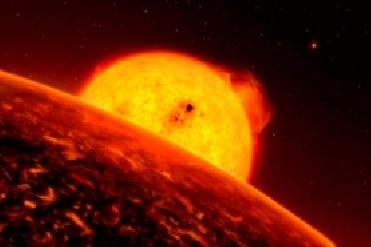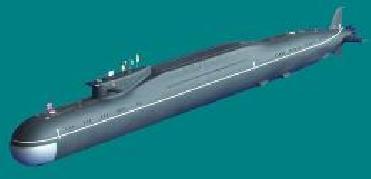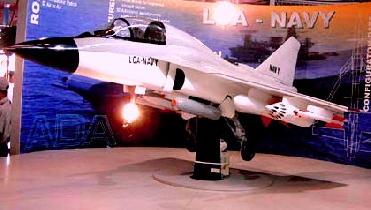
An artist's illustration of CoRoT-7b exoplanet. Image credit: ESO
PARIS (BNS): Imagine an atmosphere consisting of rock clouds and pebbles falling as raindrops!
An exoplanet detected in the constellation of Unicorn by the COROT space telescope appears to have such an atmosphere consisting of what might be called �vaporized� rocks.
Scientists who have modeled COROT-7b � the first planet outside our solar system to be confirmed last month as a rocky body � have found that its atmosphere is made up of ingredients of rocks and when �a front moves in,� pebbles condense out of air and �rain into lakes of molten lava below�, Space.com reported.
�Sodium, potassium, silicon monoxide and then oxygen � either atomic or molecular oxygen � make up most of the atmosphere,� Bruce Fegley Jr. of Washington University in St. Louis who modeled the planet along with colleagues, said.
But there are also smaller amounts of the other elements found in silicate rock, such as magnesium, aluminum, calcium and iron, he added.
The exoplanet, detected in February this year, is nearly twice the size of Earth and about five times its mass. It has a density similar to that of Mercury, Venus, Mars and Earth, making it only the fifth known terrestrial planet in the Universe.
Its equal density with the Earth indicates that the planet is likely made up of silicate rocks, just as Earth's crust is.
The planet, however, is likely to be much less hospitable to life as it is only about 2.6 million km away from its parent star �CoRoT-7� � 23 times closer than Mercury is to the sun.
And this proximity gravitationally �locks� the planet to its host star just as the Moon is �locked� to our Earth, and one side of the planet always faces the star as in the case of Moon and Earth.
This star-facing side of the planet has a temperature of about 2,326 degrees Celsius � hot enough to vaporize rock. So, unlike the much cooler Earth, COROT-7b has no volatile gases, i.e. carbon dioxide, water vapor, nitrogen, in its atmosphere. Instead its atmosphere consists of what might be called vaporized rock.
�The only atmosphere this object has is produced from vapor arising from hot molten silicates in a lava lake or lava ocean,� Fegley said.
The rock rains form similarly to Earth's watery weather: �As you go higher the atmosphere gets cooler and eventually you get saturated with different types of 'rock' the way you get saturated with water in the atmosphere of Earth,� Fegley explained. �But instead of a water cloud forming and then raining water droplets, you get a 'rock cloud' forming and it starts raining out little pebbles of different types of rock,� he said.
Elemental sodium and potassium, which have very low boiling points in comparison with rocks, do not rain out but would instead stay in the atmosphere, where they would form high gas clouds buffeted by the stellar wind from the star COROT-7.
Scientists have published their detailed findings in the latest issue of The Astrophysical Journal.
 Previous Article
Previous Article Next Article
Next Article













The Indian Air Force, in its flight trials evaluation report submitted before the Defence Ministry l..
view articleAn insight into the Medium Multi-Role Combat Aircraft competition...
view articleSky enthusiasts can now spot the International Space Station (ISS) commanded by Indian-American astr..
view article